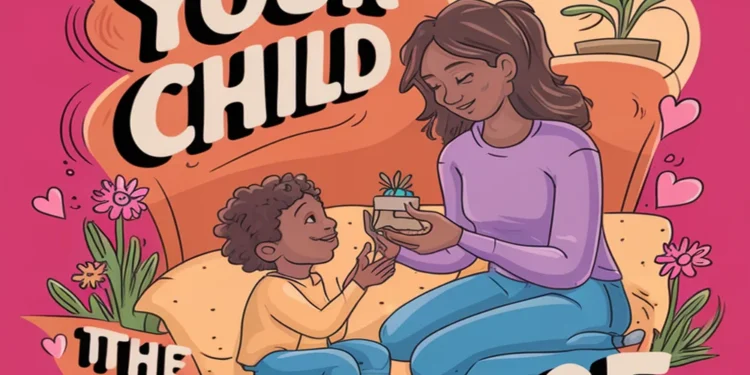To teach your child the value of gratitude, start by modeling grateful behavior yourself. Express appreciation for small things daily and create family rituals like gratitude jars. Encourage them to keep a gratitude journal, noting three things they’re thankful for each day. Foster emotional intelligence by discussing feelings and perspectives. Implement mindfulness practices, such as deep breathing and nature walks, to deepen their appreciation. There’s so much more valuable information to explore on this topic!
Understanding Gratitude and Its Importance
Gratitude is more than just a polite response; it’s a powerful emotion that enhances both our mental well-being and our relationships. When you encourage your child to express gratitude, you’ll notice they develop a more positive outlook on life. This practice fosters resilience and helps them navigate challenges more effectively. By recognizing the good in their lives, they become more empathetic towards others, creating stronger connections. Understanding gratitude also allows children to appreciate what they have, reducing feelings of entitlement. It’s important to show them that gratitude isn’t just about saying “thank you,” but about feeling and acknowledging the kindness around them. Instilling this value can transform their interactions and lead to a more fulfilling life.
Recommended Items
Explore these delightful products and tools to help instill gratitude in your child’s life!
Products
Model Grateful Behavior
When you demonstrate grateful behavior in your own life, you’re providing your child with a powerful example to follow. Children are observant, and they often mimic the attitudes and actions of the adults around them. Express gratitude for the small things, whether it’s thanking the cashier or appreciating a friend’s help. Share your appreciation for daily moments, like a beautiful sunset or a delicious meal. This shows your child that gratitude is a natural part of life. Additionally, discuss why you feel grateful, helping them connect emotions to actions. By living with gratitude, you’re teaching your child that it’s not just a concept, but a way of life that fosters positivity and fulfillment. Model it, and they’ll likely embrace it too.
Encourage Daily Gratitude Practices
After establishing a foundation of grateful behavior, it’s important to integrate gratitude into your child’s daily routine. You can make it a fun and meaningful part of their day. Here are some simple ways to encourage daily gratitude practices:
- Start meals with a gratitude round, where everyone shares something they’re thankful for.
- Create a “thank you” jar, where your child can drop notes of appreciation.
- Incorporate gratitude into bedtime routines, asking about their favorite moments of the day.
- Make a habit of sharing gratitude stories during family outings.
- Use sticky notes to jot down things they’re grateful for and stick them around the house as reminders.
These small practices can foster a lasting sense of appreciation in your child’s life.
Step-by-Step Guide to Teaching Gratitude
Keep a Gratitude Journal
Encouraging your child to keep a gratitude journal can be a transformative way to cultivate positive thinking and reflection. Start by providing your child with a special notebook, emphasizing that this is their personal space. Each day, ask them to jot down three things they’re grateful for, no matter how small. This simple act helps your child focus on the positives in their life, fostering a sense of appreciation. Encourage them to revisit old entries to see how their gratitude has evolved. Remind them that expressing gratitude can build resilience and improve their mood. Offer praise when they share their thoughts, reinforcing the importance of gratitude in their daily lives. Over time, this practice can become a cherished habit.
Express Appreciation Together
Building on the practice of keeping a gratitude journal, expressing appreciation together can deepen your child’s understanding of gratitude. When you share moments of gratitude as a family, it strengthens bonds and reinforces positive feelings. Here are some ways to do this:
- Daily Gratitude Reminders: Set a time each day to share what you’re thankful for.
- Thank-You Notes: Write notes to teachers, friends, or family members who’ve made a difference.
- Gratitude Jar: Create a jar where family members can drop in notes of appreciation.
- Celebrate Achievements: Acknowledge everyone’s accomplishments, big or small.
- Enjoy Nature: While outdoors, discuss the beauty around you and why it makes you grateful.
These activities create a shared experience that makes gratitude a family value.
Volunteer as a Family
Volunteering as a family can instantly create a powerful sense of gratitude and connection. When you work together to help others, you not only model compassion but also foster an appreciation for what you have. Choose local charities, food banks, or community events where everyone can participate. As you serve meals or gather donations, you’ll see firsthand the impact of your efforts, sparking meaningful conversations about kindness and generosity. Encourage your kids to share their thoughts and feelings after each event; this reflection deepens their understanding of gratitude. With each volunteer experience, you reinforce the idea that helping others enriches your own lives, cultivating empathy and a lasting sense of thankfulness that transcends your family unit.
Create Family Gratitude Rituals
Creating family gratitude rituals can be a meaningful way to cultivate appreciation in your home. These rituals not only help instill gratitude values but also create special bonding moments. Here are some simple ideas to get you started:
- Gratitude Jar: Each week, write down something you’re thankful for and share it together.
- Thankful Thursdays: Set aside time every Thursday to express gratitude for different things.
- Family Dinner Sharing: During meals, have each person share one thing they appreciated that day.
- Gratitude Notes: Encourage each family member to write notes to each other when they feel thankful.
- Nature Walks: Go on walks and discuss aspects of nature that evoke gratitude.
These rituals can create a lasting habit of thankfulness in your family.
Share Positive Experiences
While it’s easy to focus on what’s lacking, regularly sharing positive experiences can shift your family’s perspective towards appreciation. Make it a habit to discuss the highlights of your day during dinner or bedtime. Encourage your children to share their favorite moments and what made those times special. This practice not only reinforces joy but also creates a space for gratitude. When your family reflects on enjoyable moments, it emphasizes the good in your lives, fostering a culture of thankfulness. You might even consider keeping a gratitude journal together. Write down these moments to revisit whenever needed. This shared experience allows everyone to recognize and celebrate both the little wins and the cherished moments, nurturing an enduring sense of gratitude.
Teach the Power of ‘Thank You’
The simple phrase “thank you” carries immense power, shaping your child’s understanding of appreciation and kindness. By teaching them to express gratitude, you’re helping them foster empathy and form deeper connections with others. Start by modeling this behavior in your daily interactions.
Here are some ways to encourage your child to say “thank you”:
- Remind them to thank friends for sharing
- Encourage them to appreciate family members for their help
- Praise them when they express gratitude
- Create thank-you notes for gifts or kind gestures
- Share moments when you felt thankful
With practice, this simple phrase can become a lifelong habit, enriching your child’s life and the lives of those around them.
Identify and Acknowledge Their Feelings
Recognizing and acknowledging your child’s feelings is essential in teaching them gratitude. When they express emotions, whether it’s joy, frustration, or sadness, take a moment to listen actively. Validate their feelings by saying things like, “I see you’re upset” or “It’s great that you’re happy!” This helps them understand that their emotions are important. By doing this, you create an environment where they feel safe to express themselves, which is key to fostering an attitude of gratitude. Encourage your child to identify what they’re feeling and why. This process not only builds their emotional intelligence but also helps them see the value in what they have and appreciate the little moments in life that often go unnoticed.
Discuss the Impact of Gratitude on Well-Being
Gratitude plays a powerful role in enhancing well-being, not just for adults but for children as well. When you instill a sense of gratitude in your child, you’re helping them build a foundation for a happier life. Here are some benefits they might experience:
- Improved mood: Feeling grateful can boost their overall happiness.
- Enhanced relationships: Gratitude fosters connection with friends and family.
- Reduced stress: A grateful mindset helps lessen feelings of anxiety.
- Better sleep: Reflecting on positives can lead to more restful nights.
- Increased resilience: Grateful children are often more adaptable to challenges.
Help Them Understand Other Perspectives
While cultivating gratitude is essential, it’s equally important for your child to understand that everyone experiences life differently. Encouraging them to reflect on others’ perspectives fosters empathy and enriches their sense of gratitude. You can share stories, discuss feelings, or have conversations about different life experiences.
Here’s a simple way to illustrate this concept:
| Perspective | Example Situation | Gratitude Outcome |
|---|---|---|
| A Classmate | Struggling in school | Appreciation for help |
| A Family Member | Job loss | Value of support |
| A Neighbor | Illness | Gratitude for community |
Foster Mindfulness in Daily Life
Understanding different perspectives can lead to a deeper appreciation for what you have, but it can also be enriching to focus on the present moment. Encourage mindfulness in your child’s daily life to nurture gratitude. Here are some simple ways to do this:
- Practice deep breathing before meals or bedtime.
- Encourage them to notice nature, like the colors of leaves or the feel of the wind.
- Engage in mindful eating, savoring each bite and expressing gratitude for the food.
- Set aside quiet time where you can reflect together on the day’s moments.
- Create a gratitude jar, filling it with notes about things they appreciate.
These small practices can help your child appreciate the beauty in everyday life.
Use Books and Stories to Illustrate Gratitude
Stories and books can be powerful tools in illustrating the concept of gratitude to your child. Reading together not only exposes them to different perspectives but also helps them understand the importance of appreciation. Choose stories that highlight characters expressing thanks or showing kindness, fostering discussions about their feelings and actions.
Here’s a quick reference of books you might explore:
| Book Title | Author | Key Theme |
|---|---|---|
| “The Thank You Book” | Mo Willems | Gratitude for friends |
| “Bear Says Thanks” | Karma Wilson | Sharing and appreciation |
| “Gratitude is My Superpower” | Alicia Ortego | Empowering gratitude |
| “The Giving Tree” | Shel Silverstein | Selflessness and love |
These narratives can spark meaningful conversations about gratitude in everyday life.
Celebrate Gratitude in Special Ways
Celebrating gratitude in special ways can transform it into a cherished habit for your child. Engaging in meaningful activities helps foster a deeper appreciation for the world around them. Here are some ideas to get started:
- Gratitude Jar: Have your child write down things they’re thankful for on slips of paper and place them in a jar.
- Thank You Notes: Encourage your child to write notes to people who’ve made a positive impact in their lives.
- Family Gratitude Circle: Set aside time each week for everyone to share something they’re grateful for.
- Gratitude Crafts: Create artwork or crafts that express gratitude, using materials meaningful to your family.
- Gratitude Walks: Take nature walks and discuss things you’re thankful for along the way.
These activities build a lasting gratitude mindset!













